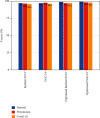An Empirical Analysis of an Optimized Pretrained Deep Learning Model for COVID-19 Diagnosis
- PMID: 35928972
- PMCID: PMC9344483
- DOI: 10.1155/2022/9771212
An Empirical Analysis of an Optimized Pretrained Deep Learning Model for COVID-19 Diagnosis
Abstract
As a result of the COVID-19 outbreak, which has put the world in an unprecedented predicament, thousands of people have died. Data from structured and unstructured sources are combined to create user-friendly platforms for clinicians and researchers in an integrated bioinformatics approach. The diagnosis and treatment of COVID-19 disease can be accelerated using AI-based platforms. In the battle against the virus, however, researchers and decision-makers must contend with an ever-increasing volume of data, referred to as "big data." VGG19 and ResNet152V2 pretrained deep learning architectures were used in this study. With these datasets, we could train and fine-tune our model on lung ultrasound frames from healthy people as well as from patients with COVID-19 and pneumonia. In two separate experiments, we evaluated two different classes of predictive models: one against pneumonia and the other against non-COVID-19. COVID-19 can be detected and diagnosed accurately and efficiently using these models, according to the findings. Therefore, the use of these inexpensive and affordable deep learning methods should be considered as a reliable method for the diagnosis of COVID-19.
Copyright © 2022 S. K. B. Sangeetha et al.
Conflict of interest statement
The authors declare that there is no conflict of interest regarding the publication of this article.
Figures
Similar articles
-
Deep-learning based detection of COVID-19 using lung ultrasound imagery.PLoS One. 2021 Aug 13;16(8):e0255886. doi: 10.1371/journal.pone.0255886. eCollection 2021. PLoS One. 2021. PMID: 34388187 Free PMC article.
-
Classification of COVID-19 and Pneumonia Using Deep Transfer Learning.J Healthc Eng. 2021 Dec 16;2021:3514821. doi: 10.1155/2021/3514821. eCollection 2021. J Healthc Eng. 2021. PMID: 34956569 Free PMC article.
-
Deep Learning Algorithm for COVID-19 Classification Using Chest X-Ray Images.Comput Math Methods Med. 2021 Nov 9;2021:9269173. doi: 10.1155/2021/9269173. eCollection 2021. Comput Math Methods Med. 2021. PMID: 34795794 Free PMC article.
-
Diagnosis of COVID-19 Using Machine Learning and Deep Learning: A Review.Curr Med Imaging. 2021;17(12):1403-1418. doi: 10.2174/1573405617666210713113439. Curr Med Imaging. 2021. PMID: 34259149 Review.
-
Machine and Deep Learning towards COVID-19 Diagnosis and Treatment: Survey, Challenges, and Future Directions.Int J Environ Res Public Health. 2021 Jan 27;18(3):1117. doi: 10.3390/ijerph18031117. Int J Environ Res Public Health. 2021. PMID: 33513984 Free PMC article. Review.
Cited by
-
Computational and Mathematical Methods in Medicine Glioma Brain Tumor Detection and Classification Using Convolutional Neural Network.Comput Math Methods Med. 2022 Oct 14;2022:4380901. doi: 10.1155/2022/4380901. eCollection 2022. Comput Math Methods Med. 2022. PMID: 36277002 Free PMC article.
-
Investigation of Applying Machine Learning and Hyperparameter Tuned Deep Learning Approaches for Arrhythmia Detection in ECG Images.Comput Math Methods Med. 2022 Sep 12;2022:8571970. doi: 10.1155/2022/8571970. eCollection 2022. Comput Math Methods Med. 2022. PMID: 36132548 Free PMC article.
-
Multiconvolutional Transfer Learning for 3D Brain Tumor Magnetic Resonance Images.Comput Intell Neurosci. 2022 Aug 23;2022:8722476. doi: 10.1155/2022/8722476. eCollection 2022. Comput Intell Neurosci. 2022. PMID: 36052054 Free PMC article.
-
TVFx - CoVID-19 X-Ray images classification approach using neural networks based feature thresholding technique.BMC Med Imaging. 2023 Oct 2;23(1):146. doi: 10.1186/s12880-023-01100-8. BMC Med Imaging. 2023. PMID: 37784025 Free PMC article.
-
A Systematic Review on Deep Structured Learning for COVID-19 Screening Using Chest CT from 2020 to 2022.Healthcare (Basel). 2023 Aug 24;11(17):2388. doi: 10.3390/healthcare11172388. Healthcare (Basel). 2023. PMID: 37685422 Free PMC article. Review.
References
-
- Kumar S., Maheshwari V., Prabhu J., et al. Social economic impact of COVID-19 outbreak in India. International Journal of Pervasive Computing and Communications . 2020;16(4)
MeSH terms
LinkOut - more resources
Full Text Sources
Medical
Research Materials









